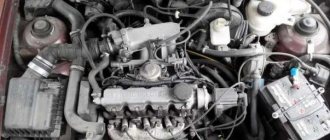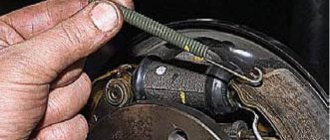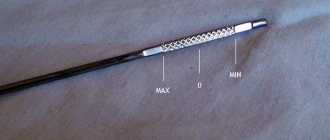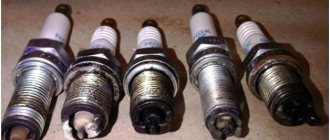Have you ever looked at the engine temperature indicator located right in front of your eyes? This means that you are lucky, the arrow stands rooted to the spot, and you simply do not pay attention to it. But not everyone is so lucky.
Some drivers complain that the needle floats like a windshield wiper blade, and when the bar indication appears, the bars change, like on an equalizer scale. How can this be explained? The article makes an attempt to systematize such phenomena and proposes measures to eliminate them.
The engine temperature arrow jumps, floats or jumps: causes and main malfunctions
So, normally the needle should rise to a certain value after the internal combustion engine has completely warmed up and not deviate from its occupied position. Note that during driving, small deviations are quite acceptable, and often to a lesser extent.
This phenomenon usually occurs in the cold season, often when driving on the highway. This is explained by the fact that in cold weather the engine is intensively cooled at high speed by counter flows of cold air.
Also, the heater takes away some of the heat from the engine in winter. As a result, the arrow may “fall” a little (by 2-3 mm from normal values). If you reduce the speed or allow the car to run at idle for several minutes, then the temperature gauge will rise to normal.
If we talk about problems, there should not be any obvious jumps in the temperature indicator. In cases where the temperature gauge needle floats, if there is a digital “stick” indication, the temperatures are constantly changing, then this serves as the main symptom of various problems. Let's figure it out.
- First, in order to understand why the engine temperature gauge needle jumps, it should be taken into account that changing readings on the indicator do not always mean that in reality such significant changes in the temperature of the internal combustion engine occur.
In other words, a change in readings within the average range of 75-95 degrees does not reflect the actual picture, since heated coolant (antifreeze, antifreeze) cannot heat up and cool down so quickly. It turns out that the indicator does not display the actual engine temperature.
Otherwise, a smooth change in readings can be taken as the norm, making allowances for the conventional error of the dial or digital indicator itself. Moreover, if temperature fluctuations do not exceed acceptable limits, it is likely that this is the operating temperature of the engine.
A cause for concern is chaotic, usually sharp fluctuations of the needle, and the amplitude of such fluctuations is quite large. In this situation, it is necessary to determine whether there really is a violation of the thermal balance, whether the indicator itself is working normally, and also for what reasons the malfunction occurred.
- So, let's go. If the system is sealed and the coolant level in the expansion tank is normal, then the most frequently failing element, on which the engine temperature directly depends, is the cooling system thermostat. Moreover, this device often fails even on completely new cars with minimal mileage. So it’s better to start checking with the thermostat.
The simplest method of initial diagnosis is to assess the degree of heating of the supply pipes going to the radiator. It is enough to touch the pipes with your hand. If the lower hose is colder than the upper hose, it is likely that the thermostat valve is stuck. As a result, even on a cold internal combustion engine, the coolant enters a large circle, and the engine cannot reach operating temperatures.
In practice, this manifests itself as follows: when the driver first warms up the engine, the temperature needle rises to operating temperatures, then the thermostat opens. Next, the coolant flows in a large circle, the engine temperature decreases, but then the thermostat jams and does not close completely.
Naturally, the liquid continues to flow partially or completely through the radiator (in a large circle). As a result, the engine begins to cool down and the temperature gauge drops. Then the thermostat will either close, after which the coolant will heat up to operating temperatures, or it will remain stuck in the jammed position and the engine will not warm up completely.
In this case, often after stopping the engine and the pressure in the cooling system drops, the needle will first rise to normal temperatures as it warms up, but then after the thermostat opens, everything will repeat again. There are also cases when the thermostat may not jam constantly, but every once in a while, and may not allow coolant access to a large circle.
In this case, the engine will overheat. It happens that the operation of the thermostat is disrupted both in opening and closing, that is, it is appropriate to talk about a combination of problems. One way or another, you need to make sure that the thermostat is working properly and normally.
- Now let's look at a situation where the engine temperature needle is jumping, but the thermostat and other elements of the cooling system are fine. In this case, the problem may be in the coolant temperature sensor (DTOZH). It turns out that if the temperature needle jumps, the culprit is often an incorrect signal from the temperature sensor.
This means that the specified sensor needs to be checked. It is important to take into account that many cars may have 2, 3 or even 4 such sensors. These sensors are also located in different places depending on the design of a particular internal combustion engine.
Also, a separate sensor sends a signal to the instrument panel so that its readings in the event of failure do not change the operation
ECM
And
ECU
engine. Having found the desired temperature sensor, you need to check its contact. It is enough to move the sensor or the terminal chip on it.
At this time, the assistant must monitor whether the temperature indicator on the instrument panel in the car interior fluctuates. Often, poor contact causes the temperature needle to fluctuate, while the cooling system works normally.
If the problem is not in contact, the sensor itself may be faulty. To check this, you should measure the resistance at different coolant temperatures. To do this, you need to know what resistance is considered normal for a sensor on one or another internal combustion engine under certain conditions.
This information can be found on specialized forums, in technical literature, etc. We also note that you should not immediately and hastily attribute all problems to the thermostat without checking the temperature sensors. The arrow can jump and jump if the contact points on the sensor are simply oxidized or the connection is loose. Moreover, surges can only occur when powerful energy consumers are turned on (heated seats, windows, headlights, etc.).
Let us also add that if the sensor itself malfunctions, the readings usually change within a certain range. If they change chaotically, then most likely there are problems with the wiring. Often the culprit is negative contact.
There have been cases when, due to problems with the “ground,” the temperature gauge showed critical overheating, and after stopping the engine, the normal 90 degrees. At the same time, measurements at the battery terminals with the engine turned off were about 12.5, after starting they rose to 13.7 V.
However, neither replacing the battery with temperature sensors nor diagnosing and checking the generator solved the problem. The way out of this situation was an additional “minus removal” of the engine.
Why the temperature arrow goes off scale - the main reasons!
The normal operating temperature of the engine on the instrument panel is 90 degrees. The arrow indicates the red zone of engine overheating. Learn more about the situation when the instrument panel does not show the engine temperature.
You can find out why the malfunction occurred in your garage, and you don’t have to go to a car service center. But to fix the problem, you may need outside help from professionals.
So, let's look at the main reasons why the temperature arrow on the VAZ-2114 dashboard goes up:
Solution methods
When the reasons are identified, you can proceed directly to eliminating them and consider the issue in more detail. So, to begin with, it is worth noting that the motorist will need some knowledge of the design features of the car, as well as knowledge of the electrical part.
Dashboard diagram
Dashboard board
The first place to look for a problem is the dashboard. In order to eliminate the malfunction, you will have to dismantle the “tidy” and also disassemble it.
The next step is to find the motor that powers the arrow. There may be two malfunctions here. Which ones exactly:
The temperature is off the charts, but does not boil! What to do???
In general, this is the case, I changed the thermostat today, because... the old one was killed (in winter the temperature dropped while driving, etc.), I poured in new antifreeze and drove off…. A few minutes later the temperature gauge went beyond the red zone, but there was no steam coming from under the hood! The fan works as it should, when you open the hood you can hear the bubbling of antifreeze in the pipe, but it does not leak out. What could it be??? Thermostat is bad or something else??? Maybe the temperature sensor is running??? Has anyone had this? The thermostat is not original, it was late, I bought one I found….
Possible causes of unstable needle oscillation
Let's start with the fact that by normal state we mean the smooth movement of the needle depending on the thermal state of the engine. There may be slight deviations from the truth, but only in a number of cases:
- At low temperatures.
- At high speed.
- Prolonged use of the stove.
This is due to the high consumption of engine energy, as well as the increased influence of cold wind or low temperature from outside. Knowing this, you can easily and simply navigate and understand the actual result. In addition, the behavior of the arrow in this case will still be stable and smooth.
Or maybe it's the sensor?
When the temperature needle moves, it only follows the changing signal that comes from the temperature sensor. It follows that if the latter is lying, then the pointer shows incorrect information. Therefore, when the pointer on the dashboard begins to misbehave, making sudden movements, you must first check the sensor.
Attention: modern internal combustion engines are equipped with 2 to 4 temperature sensors. Their installation locations may differ on different cars.
Usually there is a separate sensor on the shield so that it does not introduce an error into the operation of the electronic control system (ECU). After it is found, you should make sure that there is a contact at the connecting terminal. Rock it slightly, and let a friend watch the behavior of the arrow. Sometimes the reason is extremely simple - a loose connection or an oily terminal.
If the contact is normal, you should check the functionality of the sensor itself. To do this, use a portable ohmmeter, which measures the resistance of the element being tested at different temperatures. These values are taken from the table contained in the product documentation.
As an example, a few lines from the passport data of the coolant temperature sensor (DTOZH) 23.3828
| Temperature, °C | Resistance, Ohm |
| 100 | 177 |
| 80 | 330 |
| 50 | 975 |
| 20 | 3520 |
| 0 | 9420 |
| -10 | 16180 |
| -20 | 28680 |
Sometimes the driver is so fixated on the supposed malfunction of the thermostat that he long and persistently strives to replace it under warranty. When his efforts reach their goal, it turns out that everything remains the same. And only after replacing the temperature sensors does the indicator return to normal.
How to check
There is a lot of counterfeit goods on the Russian spare parts market. Often you come across outright dummies. Therefore, before installation, experts recommend checking the coolant temperature sensor, whether on a VAZ 2114 or on any other car. This is quite simple to do; the main thing is to have a multimeter (tester).
Convert the meter to an ohmmeter. At room temperature (+23 °C, +25 °C), the readings should be within 2780 Ohms (as in table No. 1). If you place the DTOZH in a glass of boiling water (+100 °C), hold it for a while and take readings, a result of 175–180 Ohms should appear on the tester screen. If so, then the purchase is in good condition. Now you can safely install it on your car.
Unpleasant surprises from engine maintenance.
Hello. Today I want to talk about the coolant temperature sensor and the malfunctions associated with it. Picture from free access to the Internet.
Brief information
.The coolant temperature sensor (TES) is an important element of the electronic engine control system (ECM).
The sensor is designed to measure engine temperature.
Based on a signal from this sensor, the ECM, according to the program embedded in it, controls the fuel supply, adjusts the ignition angle, turns the engine cooling system fan on and off. Structurally, the sensor is a thermistor that has a negative temperature coefficient, i.e., as the temperature increases, its resistance decreases.
The thermistor itself is placed in a heat-conducting housing with a thread. A plastic connector with 2 thermistor leads is built into the case.
The sensor must have direct contact with the coolant.
In fact, this seemingly simple sensor can bring a lot of unpleasant moments to the car owner.
Symptoms of a malfunction of this sensor may be the following:
- jerking and jerking when the car is moving;
- increased fuel consumption (black carbon deposits on spark plugs);
- increased idle speed;
- poor starting when hot, and in some cases also when cold;
- engine overheating due to incorrect DTOZ values.
The most common reasons: a break inside the DTOZh or the wires leading to it. In this case, the engine malfunction lamp comes on, error: “Engine temperature sensor circuit malfunction.”
But there are also more insidious reasons: the DTOZh can give incorrect readings on the coolant temperature, that is, show a temperature lower than it actually is. For example, it can lower the temperature by 10-15 degrees. In this case, the fault lamp does not light up. The ECM does not send a signal to the engine cooling fan relay in time. The coolant level in the reservoir begins to rise, which can lead to engine overheating. In this case, only the indicator on the instrument panel can show the real temperature.
In this case, you can remove the DTOZH, heat it separately in a kettle and measure with a tester how its resistance changes according to the table.
But it’s better to buy a new one, since these sensors are inexpensive.
The next problem is poor starting on a cold engine. In this case, the error does not appear either. The temperature sensor, on the contrary, shows too high a temperature. For example, the outside temperature is -10 degrees, but the sensor shows +25 degrees. With such a difference, the engine may not start at all. It simply doesn't have enough fuel to start.
Many times such cars were dragged on a cable. When you connect the scanner, everything becomes clear.
I hope the article will be useful to diagnosticians and car enthusiasts.
I would be grateful if
you subscribe to the channel and like the article . If you have any questions, write in the comments, I will try to answer them.
Source
The engine temperature arrow jumps: we analyze the reasons
In order to timely identify problems associated with the car’s cooling system, it is necessary to monitor the engine temperature level using a special indicator on the dashboard. If over time the indicator changes smoothly within the range from 90 to 105 degrees, then there are no malfunctions. However, if the needle jumps chaotically and goes beyond such numbers, then there are problems associated with cooling the internal combustion engine.
The reasons for this problem are:
1. Faulty thermostat. To recognize such a defect, it is necessary to compare the temperature of the radiator pipes on a hot engine. If the lower one is colder than the upper one, then the suspicions are correct. This indicates that the thermostat valve is not closing completely and the engine is not heating up as expected. Despite the fact that this problem occurs after 60-70 thousand kilometers, it also occurs on new cars.
2. Problems with the sensor. Since the arrow indicator directly depends on the sensor signal, complications may arise due to the latter. However, it is worth considering that many modern car models have several sensors installed. Verification is required on everyone. Pay special attention to terminals that often oxidize. As a result, the contact is insufficient for transmission.
3. Presence of air in the cooling system. Since the temperature of the air and cooling liquid is different, when they come into contact with the sensor, the needle jumps in different directions. You can check this by opening the antifreeze reservoir and pressing on any of the pipes several times. If air bubbles come out of it, then the assumption is confirmed. To get rid of this, you need to add more coolant and pump out the air by pressing on the pipes.
4. Electronic board malfunction. Occurs if the soldering was done unreliably.
It can be noted that there are not many reasons for the malfunction of the arrow indicating the engine temperature. However, if the car owner notices that it is jumping in different directions and goes beyond the permissible temperature limits, it is necessary to check each of the possible breakdown options. Since it is not uncommon to encounter circumstances in which the cause may be a malfunction of several elements.
Source
The temperature needle jumps when the thermostat and DTOZh are working
In some cases, it happens that the thermostat, as well as the temperature sensor and wiring, turn out to be working. In this case, the temperature arrow jumps arbitrarily, overestimating or underestimating the readings, in an arbitrary range.
Often the problem lies in the electronic board of the instrument panel. If the soldering of such a board turns out to be of poor quality, problems arise after a few years. The malfunction can be eliminated by disassembling the shield and re-soldering. As part of such work, special attention should be paid to resistors and output mass. If you plan to do the work yourself, you need to have a low-power soldering iron with a thin rod.
We also note that the needle, with other elements in good working order, both mechanically and electrically, can jump if the engine cooling system is airy. In other words, the air in the cooling system forms an air lock. This plug heats up much faster and more strongly than antifreeze or antifreeze.
As a result, the sensor reacts to changes in temperature, the pointer arrow changes position chaotically. At the same time, the air in the system is indirectly indicated by the fact that liquid is leaking from under the cap of the expansion tank, there may be a noticeable decrease in the level in the tank, etc.
How to remove the coolant temperature sensor from a VAZ 2114?
First, you need to pay attention to the fact that the power unit of the car model in question usually operates at a temperature of 80-90 degrees. This is the ideal temperature, but variations are possible depending on certain factors. If the engine heats up for a long time or quickly, then the problems need to be solved. So, to replace you will need to do the following:
- let the car cool down;
- prepare keys 8, 13, 17;
- prepare a container for draining the coolant;
- remove the power unit protection;
- disconnect the radiator fasteners;
- turn on the stove, and then open the tap and the expansion tank cap;
- Place a container under the radiator and unscrew the cap. Work must be done slowly because the coolant is under pressure;
- place the container under the radiator for 10-15 minutes;
- Place the container under the engine and unscrew the cover from the cylinder block (it is located under the ignition module).
At the next stage, you need to find the temperature sensor, remember its location and remove it using the 21 key. Next, you need to install a new device with the corresponding marking. The sensor should be in the same position as its predecessor.
For a quality connection, it is recommended to apply heat sealant to the threads. After this, all that remains is to add coolant. Then you need to start the car and look at the VAZ 2114 coolant temperature indicator sensor , making sure that the system is functioning normally.
Unfortunately, after all the operations performed, the device does not always work as expected. It is recommended to ensure that the new sensor is installed correctly. Sometimes motorists forget to add fluid to the system. But there are also situations when the product turns out to be defective. The car may be unstable. Therefore, if replacing the sensor on your own does not bring the desired result, the car owner has only one thing left - contacting a trusted car service center.
( 1 rating, average 4 out of 5 )
I have contact
As electricians say, there can only be two faults: there is no contact where needed, or there is contact where it is not needed. This rule also applies in the situation under consideration. The arrow will jump if the joints are oxidized or weakened. Moreover, most often this happens when additional consumers are connected: low beam, headlights, etc.
As mentioned above, the first thing to do when diagnosing DTOZH is to check the contact in the connector. Returning to the previous section, the following should be added: if the sensor malfunctions, the readings fluctuate within the same range, and if they change chaotically, the wiring may be damaged. How important the negative contact is - the mass - will be confirmed by one case described by a forum participant.
The gauge needle sometimes jumped to 130°C. After stopping the engine, it showed the correct result - 90°. The voltage at the battery terminals when the engine was not running was about 12.5 V, and after starting it rose to 13.7.
After a year and a half of unsuccessfully searching for the cause, replacing the battery, alternator and two temperature sensors, I came across one grandpa who installed an additional ground wire from the engine to the body, and the problem was solved.
Is the thermostat to blame?
Forum participants often ask: why does the engine temperature gauge needle jump? Before answering, you should clarify the formulation of the question itself. Changing instrument readings do not necessarily mean that the engine temperature is fluctuating.
For example, the needle swings in a sector from 70 to 90 degrees or oscillates chaotically with a large amplitude. But heated coolant (coolant) has thermal inertia and cannot change its parameters so sharply. It follows that the instrument readings may not reflect the actual temperature of the internal combustion engine (ICE).
If the readings change rather slowly, we can assume that they show the actual degree of heating of the motor. In this case, it is necessary to critically assess the situation: are temperature fluctuations really dangerous? When they occur in the range of 90 to 105°C, there is no cause for alarm, since this is the normal operating temperature that the thermostat maintains.
Now, if smooth fluctuations go beyond this range, then you should look for the reasons for the violation of the thermal balance. The thermostat may be the culprit. But this still needs to be verified.
The easiest way is to try heating the supply pipes to the radiator by touch. The suspicion is confirmed when the lower pipe is slightly colder than the top. This means that the thermostat control valve is stuck open and the engine is running underheated. A similar thermostat malfunction is usually encountered after 70 thousand kilometers.
The engine temperature arrow jumps: why does this happen and what should the driver do?
Many drivers are well aware that constant monitoring of engine temperature allows timely detection of possible problems with the cooling system and protects the engine from overheating and costly repairs. For this reason, experienced car owners constantly pay attention to the internal combustion engine temperature indicator while driving a car.
In this article we will talk about why the engine temperature arrow rises, then the pointer drops, and also why the power plant temperature sensor may give incorrect readings, the engine temperature arrow floats while driving, etc.
conclusions
There are not many reasons why the VAZ-2114 engine temperature needle goes off scale, but all of them are quite difficult to diagnose, and some can only be eliminated in a car service center. Therefore, if the motorist has not carried out repair operations of this nature, it is necessary to contact a car service center, where they will help and repair everything.
Have you ever looked at the engine temperature indicator located right in front of your eyes? This means that you are lucky, the arrow stands rooted to the spot, and you simply do not pay attention to it. But not everyone is so lucky.
Some drivers complain that the needle floats like a windshield wiper blade, and when the bar indication appears, the bars change, like on an equalizer scale. How can this be explained? The article makes an attempt to systematize such phenomena and proposes measures to eliminate them.
Attention - air
Finally, another possible reason for sudden movements of the needle is the presence of air bubbles in the antifreeze (“airing” of the system). Since the air and antifreeze have different temperatures, the needle jerks. An indirect sign of this malfunction is the splashing of coolant from the radiator cap or expansion tank, as well as a decrease in the filling volume.
To summarize, we can suggest the following order for checking the elements: contacts, ground, temperature sensor (DTOZH), thermostat, indicator board. Owners of Renault Logan should not dramatize the 2-4-2 display. This is normal thermostat operation.
PS In order not to upset Logan drivers, on the Duster and the second generation Logan-Sandero the temperature indicator on the dashboard was completely removed. As they say: no pointer, no problem.











